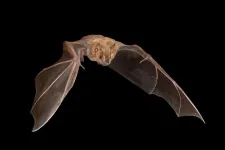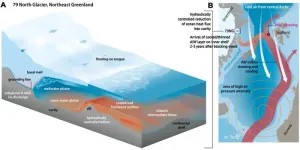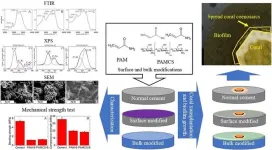(Press-News.org) Per- and polyfluoroalkyl substances (PFAS) are human-made chemicals that were introduced in the 1940s. PFAS are used to create a variety of products including water-resistant clothing, non-stick cookware, and firefighting foams.
Unfortunately, PFAS can have negative effects on health, including increases in cholesterol levels and changes to liver function. Using PFAS-containing products can lead to their presence in the treated wastewater and treated sludge (referred to as biosolids). When grown on biosolid-amended farmland soils or irrigated with treated wastewater, crops can bioaccumulate PFAS. The PFAS-accumulated crops can be consumed directly by the public or indirectly by farm animals, resulting in PFAS in our food supply and creating a public health concern.
Dr. Kung-Hui (Bella) Chu, a professor in the Zachry Department of Civil and Environmental Engineering and her co-investigator, Dr. Libo Shan, a professor at the University of Michigan, have received $1.6 million in funding from the Environmental Protection Agency to research PFAS mitigation and monitoring techniques.
“The main outcome of this project will be to empower agricultural communities and wastewater professionals with an increased ability to manage PFAS risk associated with the beneficial uses of biosolids and reclaimed water,” said Chu.
In 2021, the US generated approximately 4.5 million dry metric tons of biosolids, with 25% used for agricultural application. In 2018, approximately 1.5 million acres of agricultural land in the United States were irrigated with recycled or reclaimed water to address the water scarcity concern. Land applications of biosolids and recycling water is economically beneficial; however, the potential for PFAS contamination creates concerns over the safety of these practices. The ability to accurately monitor and mitigate PFAS has the potential to reduce the contamination risk, allowing these beneficial uses to become safer, more common practices.
“Our long-term goal is to comprehensively understand PFAS uptake and bioaccumulation in plants across various nutrient conditions, to advance strategies for PFAS remediation in biosolid/soil, minimize PFAS uptake by plants, and develop real-time monitoring tools for PFAS in biosolids, biosolid-amended soils, and irrigation water,” said Chu.
By Alyssa Schaechinger, Texas A&M Engineering
###
END
Planting seeds for safer farming
EPA-funded research will improve our understanding of human-made chemicals called PFAS.
2024-09-24
ELSE PRESS RELEASES FROM THIS DATE:
Fruit-only diet improves bats’ immune response to viruses
2024-09-24
Fruit bats generate more diverse antibodies than mice, but overall have a weaker antibody response, according to a new study published September 24th in the open-access journal PLOS Biology by Dan Crowley from Cornell University, USA, and colleagues.
Bats are well-known reservoirs for viruses with pandemic potential. While these viruses typically do not cause disease in bats, they can prove deadly in humans. Spillover events—transmission of a virus from a reservoir population (eg, bats) to a new host population ...
Placebo pain relief and positive treatment expectations are not caused by dopamine
2024-09-24
New findings argue against a direct causal role for dopamine during the experience of a treatment effect in the establishment of positive treatment expectations and placebo analgesia in healthy volunteers, according to a study published September 24th in the open-access journal PLOS Biology by Ulrike Bingel from University Hospital Essen, Germany, and colleagues.
Dopamine-based reward and learning mechanisms have been suggested to contribute to placebo effects. However, the exact role of the brain messenger molecule dopamine in their generation and maintenance is still unclear. ...
New guideline details how to manage CVD risk before, during & after noncardiac surgery
2024-09-24
Guideline highlights:
The American Heart Association and the American College of Cardiology joint guideline addressing cardiovascular evaluation and management of patients before, during and after noncardiac surgery reviews a decade of new evidence and provides updates since the last guideline in 2014.
The updates in the guideline are intended for patients scheduled for noncardiac surgery from preoperative evaluation through postoperative care and include appropriate use of cardiovascular testing and screening, management of cardiovascular conditions and risks, and recommendations for those taking sodium-glucose ...
Silvia Cavagnero to receive 2025 Emily M. Gray Award
2024-09-24
ROCKVILLE, MD – The Biophysical Society is pleased to announce that Silvia Cavagnero, PhD, of the University of Wisconsin-Madison, has been named the recipient of the 2025 Emily M. Gray Award. Cavagnero will be honored at the Society’s 69th Annual Meeting, being held in Los Angeles, California from February 15-19, 2025.
Cavagnero is being honored for developing courses, innovating instructional methods, mentoring students at all levels, and promoting diversity in biophysics.
“Silvia is an accomplished biophysicist and a born educator,” ...
European Society of Endocrinology expands journal portfolio with the launch of Environmental Endocrinology and Obesity and Endocrinology
2024-09-24
The European Society of Endocrinology (ESE) is delighted to announce the launch of two new multidisciplinary, open-access journals, Environmental Endocrinology and Obesity and Endocrinology. The Journals will be published by Oxford University Press, with the launch issues scheduled for Q2 2025. Submissions are now being welcomed via the Journals' websites.
Environmental Endocrinology will publish high-quality clinical, translational, and basic research on all aspects of environmental impacts on hormone systems in humans and living systems, incorporating the One Health perspective. The Journal will welcome submissions from a broad range ...
Atmospheric blocking slows ocean-driven melting of Greenland’s largest glacier tongue
2024-09-24
Northeast Greenland is home to the 79° N Glacier – the country’s largest floating glacier tongue, but also one seriously threatened by global warming: warm water from the Atlantic is melting it from below. Experts from the Alfred Wegener Institute have however now determined that the temperature of the water flowing into the glacier cavern declined from 2018 to 2021, even though the ocean has steadily warmed in the region over the past several decades. This could be due to temporarily changed atmospheric circulation patterns. ...
Improved cement to protect the living treasures of our coastlines
2024-09-24
WASHINGTON, Sept. 24, 2024 – Coastlines are vital to our world’s ecology and economy. Coastal ecosystems help maintain biodiversity, provide natural barriers against erosion, storms, and flooding, and act as large carbon sinks to reduce greenhouse gases. Sustainable fisheries and seaside tourist venues support local economies.
Natural coastlines, including coral reefs, marshes, and mangroves, are complete and stable, capable of self-regulation and restoration. That is, unless human interventions, such as urbanization, overdevelopment, pollution, and human-made erosion, make these areas vulnerable to devastation.
Artificial coastlines, ...
Absolute and functional iron deficiency in the US
2024-09-24
About The Study: The findings of this study suggest that absolute and functional iron deficiency affect a large proportion of American adults even in the absence of anemia, heart failure, or chronic kidney disease. Further research on the role of functional iron deficiency in adverse health outcomes and on iron deficiency screening strategies is needed.
Corresponding author: To contact the corresponding author, Leo F. Buckley, Pharm.D., M.P.H., email lfbuckley@bwh.harvard.edu.
To access the embargoed ...
Rural-urban disparities in hospital services and outcomes for children with medical complexity
2024-09-24
About The Study: Rural-residing children with medical complexity were significantly more likely to present to hospitals without dedicated pediatric services in this cohort study. These findings suggest that efforts are justified to ensure that all hospital types are prepared to care for children with medical complexity.
Corresponding author: To contact the corresponding author, JoAnna K. Leyenaar, M.D., Ph.D., M.P.H., email joanna.k.leyenaar@hitchcock.org.
To access the embargoed study: Visit our For The Media website at this link https://media.jamanetwork.com/
(doi: 10.1001/jamanetworkopen.2024.35187)
Editor’s Note: Please ...
Fewer than half of US jails provide life-saving medications for opioid use disorder
2024-09-24
A new look into addiction treatment availability in the U.S. criminal justice system reveals that fewer than half (43.8%) of 1,028 jails surveyed across the nation offered any form of medication for opioid use disorder, and only 12.8% made these available to anyone with the disorder. With two-thirds of people who are incarcerated in U.S. jails experiencing a substance use disorder – in many cases, an opioid use disorder – the failure to make these medications widely available in criminal justice settings represents a significant missed opportunity to provide life-saving treatments in an environment where people in need of care can be easily reached.
The study, published ...
LAST 30 PRESS RELEASES:
Norbert Holtkamp appointed director of Fermi National Accelerator Laboratory
New agentic AI platform accelerates advanced optics design
Biologists discover neurons use physical signals — not electricity — to stabilize communication
Researchers discover that a hormone can access the brain by hitchhiking
University of Oklahoma researcher awarded funding to pursue AI-powered material design
Exploring how the visual system recovers following injury
Support for parents with infants at pediatric check-ups leads to better reading and math skills in elementary school
Kids’ behavioral health is a growing share of family health costs
Day & night: Cancer disrupts the brain’s natural rhythm
COVID-19 vaccination significantly reduces risk to pregnant women and baby
The role of vaccination in maternal and perinatal outcomes associated with COVID-19 in pregnancy
Mayo Clinic smartwatch system helps parents shorten and defuse children's severe tantrums early
Behavioral health spending spikes to 40% of all children’s health expenditures, nearly doubling in a decade
Digital cognitive behavioral treatment for generalized anxiety disorder
Expenditures for pediatric behavioral health care over time and estimated family financial burden
Air conditioning in nursing homes and mortality during extreme heat
The Alps to lose a record number of glaciers in the next decade
What makes a good proton conductor?
New science reporting guide published for journalists in Bulgaria
New international study reveals major survival gaps among children with cancer
New science reporting guide published for journalists in Turkey
Scientists develop a smarter mRNA therapy that knows which cells to target
Neuroanatomy-informed brain–machine hybrid intelligence for robust acoustic target detection
Eight SwRI hydrogen projects funded by ENERGYWERX
The Lundquist Institute and its start-up company Vitalex Biosciences Announces Strategic Advancement of Second-Generation fungal Vaccine VXV-01 through Phase 1 Trials under $40 Million Competitive Con
Fine particles in pollution are associated with early signs of autoimmune disease
Review article | Towards a Global Ground-Based Earth Observatory (GGBEO): Leveraging existing systems and networks
Penn and UMich create world’s smallest programmable, autonomous robots
Cleveland researchers launch first major study to address ‘hidden performance killer’ in athletes
To connect across politics, try saying what you oppose
[Press-News.org] Planting seeds for safer farmingEPA-funded research will improve our understanding of human-made chemicals called PFAS.




